But wait a second…
So, the 1Ds II is about a stop better at high ISO….or is it? I started thinking…in pure noise performance, yes, it is. However, I’m not concerned with the technical performance of something…I’m concerned about the final print, or final image on screen. It’ s like when you have a car that has a 600 hp engine vs one that has a 480 hp engine. Yes, one has a more powerful engine, but what if the 480hp car weighs 20% less?
This was my thinking, and the detail advantage of the Micro 4/3 bodies is the lower weight of the car. That is, if I can use noise reduction techniques and still get a file with the exact same amount of detail, then that should be the real comparison. So, I kept the 1Ds II files the same, and increased luminance noise reduction in Lightroom until I achieved what to my eye was identical levels of detail between the three cameras. This ended up being at around a level of 20-40 depending on the ISO.
The following are the crops with noise reduction tweaked to yield a similar final level of fine detail (only showing base ISO and 1600 and higher):
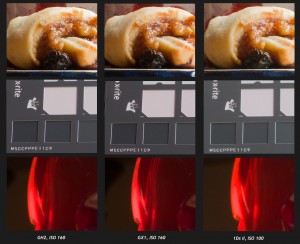
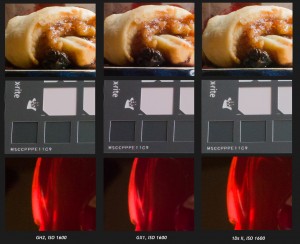
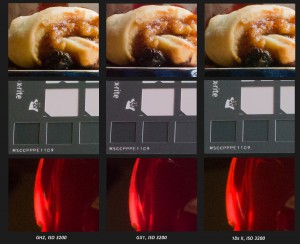
And for fun, I also shot one of the 1Ds II shots at ISO 3200, underexposed by a stop and then pushed in post by a stop to yield effective ISO 6400:
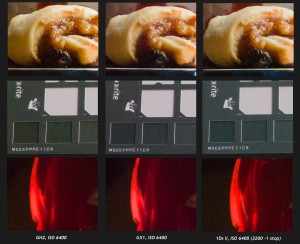
My thoughts:
Wow – that’s interesting! At base ISO, the light noise reduction has eliminated the fine grain noise present in the Micro 4/3 shots, while leaving detail essentially untouched. At least, to my eyes, it still seems like the GH2 and GX1 are resolving more fine detail than the 1Ds II, with identical noise performance. The 1Ds II still does obviously retain a dynamic range lead.
At ISO 1600, the GH2 and GX1 are again able to match or beat the 1Ds II in resolution, and noise performance looks essentially identical here. The GH2 is falling a little off the pace in the red shadow crop, where a little bit of artifacting has crept in. The GX1 stays solid here, though.
At ISO 3200, the GH2’s color shift is visible, and it’s shadow detail has deteriorated a little more, but it’s right with the others in the mid-tones and highlights, as well as in resolution. With the noise reduction here, there is no longer a detail advantage to the Micro 4/3 bodies, but they look equal to the 1Ds II. Overall, the GX1 and 1Ds II crops look extremely similar to my eyes, with the GX1 maybe having a little less noise with this processing in the midtones and highlights, while the 1Ds II has a tiny bit cleaner look in the red shadows.
At ISO 6400, the GH2’s color shift becomes rather extreme, and it is exhibiting some pattern noise in the red shadows. The GX1’s noise profile is very close to the 1Ds II, but the 1Ds II is holding a very slim advantage in the appearance of the noise. It is more film like here, while the GX1’s looks more digital. This is especially noticeable in the shadows. Still, the difference would likely be extremely difficult to notice except in large prints.
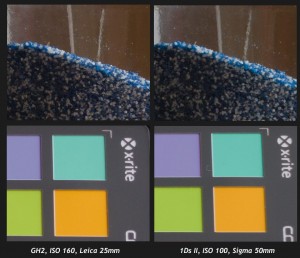
Just a side note with the image above, which are crops taken from the left and right sides of the image at base ISO…you can see that color response in the blues and purples and greens is essentially identical here. The GH2 does still hold on to a slight resolution advantage at the edges here (though this could possibly be due to the lens).
Conclusion:
Well, that was interesting. You can make up your own mind here, but I see a few key points:
- The GH2 and GX1 hold a real world resolution advantage over the 1Ds Mark II despite the similar megapixel count, likely due to a lighter anti-aliasing filter.
- The 1Ds Mark II has better dynamic range than the Micro 4/3 cameras, which is visible as extra shadow detail.
- The 1Ds II has about one stop better noise control in pure sensor performance.
- Due to the resolution advantage, that one stop advantage can be negated up through ISO 3200 by proper RAW noise reduction, yielding similar noise performance and similar or better detail for the GH2 and GX1
- In my eyes, color performance is essentially identical. There may be a difference, but I’ll be darned if I can see one with my eyes.
So, in my mind, for base ISO work, the GH2 and GX1 should be able to give you shots of similar quality to the legendary 1Ds Mark II, provided you don’t need the 1Ds II’s extra dynamic range. Even at high ISO, these tiny cameras are able to hang in there with the 1Ds II all the way through to ISO 3200, with the GX1 able to come extremely close even at ISO 6400. It’s an exciting time when little mirrorless cameras can achieve image quality at this level.

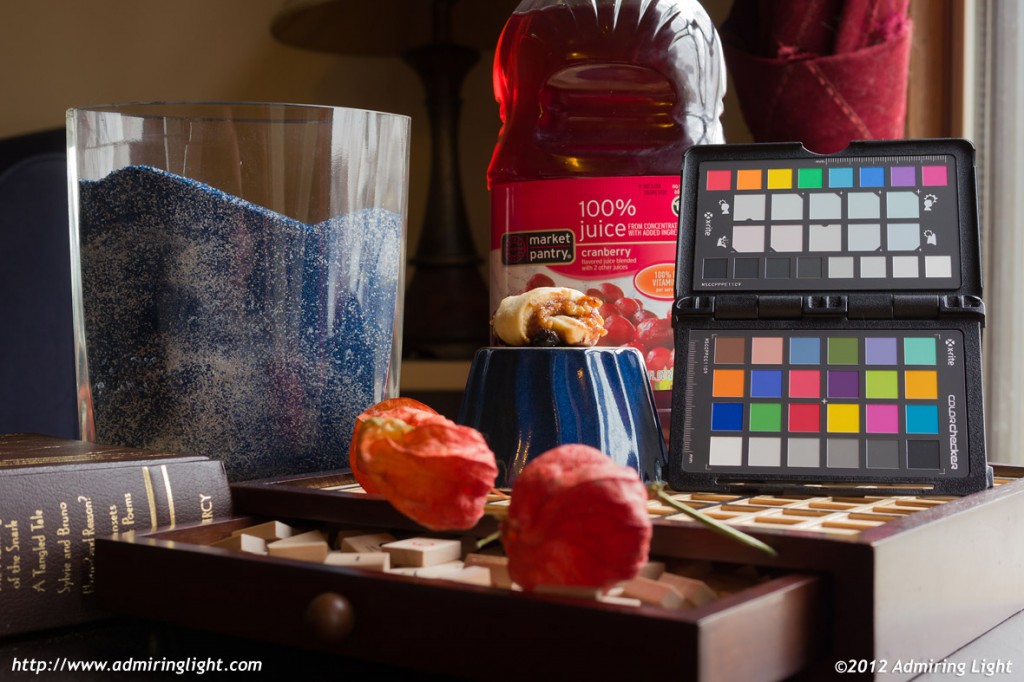

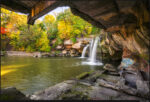

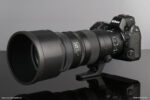
Leave a Reply